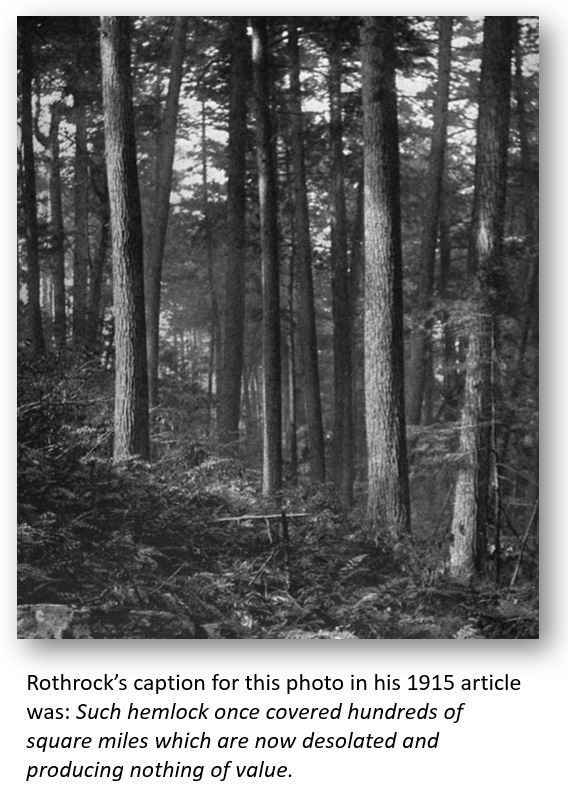The first state forester of Pennsylvania was Joseph T. Rothrock. Rothrock, a medical doctor, appreciated the benefits that forests could have on people suffering from tuberculosis and other respiratory diseases. In fact, he established at least three "sanitariums" away from cities and near forests where sick people could come to recuperate. Dr. Rothrock made a speech on March 23, 1915[1] to the state legislature and public in Harrisburg. Like Henry Shoemaker, Rothrock also encouraged conservation. Among his comments:
Thousands of square miles were robbed of the timber in advance of any actual need, and the naked soil abandoned for fire and flood to impoverish and make unproductive! It is scattered over the central parts of the State, on the highest plateaus, about the headwaters of the streams and on the shaly slopes of the inferior ridges. Agriculture has been attempted on a portion of it, and often proved so unremunerative that the land and the farmer grew poorer with each succeeding year.
If it were possible to gather these acres together they would make an area 80 miles long an 80 wide, which is about one-seventh the area of the State.
It is an astonishing statement that in my lifetime I have seen practically one-seventh of this Commonwealth cease to produce wealth, power, or food for the remainder of the State!
Sixty years ago from the mouth of the Sinnemahoning, northwest to the Allegheny River at Warren, 75 miles as the crow flies, was an almost unbroken forest. I walked from Clearfield to Saint Marys and thence to Smethport – 60 miles; most of the way through glorious white pine and hemlock forests, of which hardly a vestige now remains. Those forests are but a memory!
I have no contention with the lumbermen of those days. The timber was there. It was nature. It was thought to be needed as fast as it was cut.
The men who cut the trees and the men who sawed the logs into lumber have left. The country is the poorer because they have gone; for they were industrious, strong-armed, brave-hearted men, loyal and efficient in the Wars of the Revolution, 1812, and the Rebellion.
But how about the land? Too poor to farm for the most part, often without mineral resources, it was simply abandoned, practically uncared for. Today [1915] one may safely say there are 3,000,000 acres of such unprotected land in the State of Pennsylvania.
The mistake was in the failure to realized that production of forests was the one predestined function of our mountain ranges and stony ridges, and, of course, as a consequence no one thought of putting them back to timber – as Germany, France, or Switzerland would have done. Ignorance often invites, but seldom averts, a penalty. . . .
Will nature, unassisted, restore forests to the waste places of the State? Certainly not, unless forest fires are absolutely prevented. It by no means follows, however, that the naturally restored growth is the best timber or, indeed, that it is timber at all in the proper sense of the word.
The first essential in forestry is prevention of forest fires. The word prevention is used advisedly. Hitherto extinguishing forest fires and suppressing forest fires have been the leading ideas in our forest fire code. The one idea to get is that forest fires must be prevented by the presence of a sufficient patrol; second, of promptly extinguishing them, if started, and, third, of discovering how the fire was started and promptly bringing the offender to punishment. . . .
The one point desired to be impressed here is the magnitude of the work of restoring timber to from four to six million of acres, and doing it as promptly as possible. State work, however, necessary is always slow.
The policy to be adopted for such lands as are better adapted to the growth of timber than any other crop is:
First. Replant the treeless land with seedlings of the most desirable species so far as possible.
Second. Carefully safeguard against fire the most promising lands on which there exists a reasonable stand of timber, and underplant in it the shade enduring species as much as possible.
Third. Protect the remaining soil of the steep, rocky, treeless parts by any growth, however worthless, if it will only afford a soil cover while living, and aid in producing soil when dead.
The lesson of the waste lands is: Plant what you can at once, and for the rest aid nature in covering them with whatever will grow best, and prevent destructive washing away of soil. Bear in mind that the whole problem of forest restoration is urgent, though some portions of the work are more urgent than others. Note, however, that where forest fires are tolerated, the best forestry efforts will produce small results.
Even under the most favorable conditions the State will, for many years, miss the income formerly received from its lumber industries, which once aggregated nearly $30,000,000 annually as the lumber fell from the saw.
[1] The speech was based on an article Rothrock had published in the newsletter of the PA Forestry Association, titled Forest problems in Pennsylvania, in Forest Leaves 15(2): 24-26, 1915.

